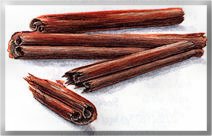

Cinnamomum zeylanicum, C. cassis,


Cinnamomum zeylanicum, C. cassis,
Synonyms - cassia, Ceylon cinnamon or Saigon cinnamon
Description - Cinnamon is a spice that is from the family of plants known as Lauraceae. The specific portion of the plant used to make the popular spice is the dried inner bark. There are dozens of different species of the cinnamon plant. The Chinese cinnamon, known as Cinnamomum cassis, is more readily available and mass produced. It has been said that the dark cinnamon powder made in Sri Lanka, Cinnamomum zeylanica, is the finest available. Cinnamon is a spice made from the highly aromatic reddish or yellow brown bark of several trees of the genus Cinnamomum. Cinnamon trees are relatively small, about 30 feet in height. They have stiff oblong evergreen leaves and silky clusters of yellowish white flowers with dry pointed fruit. Before harvesting, the stems are slit on each side. The outer corky bark is pulled off and the aromatic inner portions are scraped into "quills" and baled for export. The finest quality cinnamon comes from the Cinnamomum zeylanicum of Sri Lanka. The Cinnamomum evergreens of the Lauraceae family grow in Java, the West Indies, Brazil, and Egypt. They have even been grown in limited number in California and south Florida.
Cinnamon is an ancient spice. The Egyptians, Greeks, and Romans all obtained the valuable spice from Arabian traders. In search of these spices, the Portuguese, in the 1500’s, discovered a new route around Cape Horn to Sri Lanka. Centuries ago, some spices were so much in demand that some believe these spices, including cinnamon, helped potentiate trade between the Asian and African continents. The Egyptian civilization found the cinnamon spice a unique product and used it in the embalming process. During the time of Moses, cinnamon was considered a prized spice and a commodity that was available through trade.
Medicinal uses - The extracted cinnamon oil is used as a flavoring and pharmacologic ingredient for medicinals, particularly mouthwashes. It is also known that:
Pharmacology - Cinnamon and Free Radicals - In May of 1995, a study by the Japanese to assess the superoxide dismutase-like activity of natural antioxidants. Superoxide dismutase (SOD) is widely recognized as one of the body’s main antioxidant enzymes. In that study, a variety of natural antioxidants were tested for their free radical scavenging ability. Among the things measured were ascorbic acid (vitamin C), glutathione, catechins and epitcatechins (found in green teas). These natural antioxidants are water soluble antioxidants. Cinnamon, however, is a lipophilic antioxidant (fat-soluble). Other lipophilic antioxidants were also tested, such as gamma oryzanol, rosemary leaf, alpha-lecithin, and alpha-cephalin. The results of this study indicated that cinnamon contains oils which have SOD-like activity.
Other Cinnamon Applications - Cinnamon is not just a spice that is meant for oral ingestion. There are many other applications to cinnamon. Today, we can find cinnamon utilized for non-food applications. For example, cinnamon is routinely found in lip sunscreen, toothpaste, mouthwashes and chewing gum. These applications of cinnamon definitely make sense, when we consider that cinnamon has astringent and antimicrobial characteristics. Basically, not only will it freshen your mouth, but it may also inhibit the spread of pathogenic bacteria on the lip, tongue and oral cavity. An incredible experiment in the journal of Food Science for 1974 demonstrates the power of cinnamon over most yeasts and fungi. Slices of white, raisin, rye and whole wheat breads, manufactured without the usual mold inhibitors, were subjected to various aflatoxins, a group of toxic molds so dangerous that they can cause liver cancer and kill humans and animals alike. These toxins often occur in food. The toxic molds grew like crazy on all of the other breads, except for the raisin bread where growth was described as being "scant or not visible at all." In trying to identify whether it was the raisins or cinnamon responsible for this, food scientists discovered that as little as 2% or 20 mg. of the spice per milliliter of a yeast -extract and sucrose broth inhibited 97 -99 per cent of these molds.
Dosages - To make a tincture, combine 10-1/2 tbsp. powdered cinnamon in 1-1/4 cups of vodka. Add enough water to make a 50% alcohol solution. Put in a bottle and let set somewhere for two weeks, shaking once in the morning and again in the evening. Then strain and, pour the liquid into a bottle suitable for storage. This tincture will last a long time.
Contra-indications - Cinnamon is a uterine stimulant and should be limited or not used during pregnancy! It can also be a skin irratant by those sensitive to cloves!